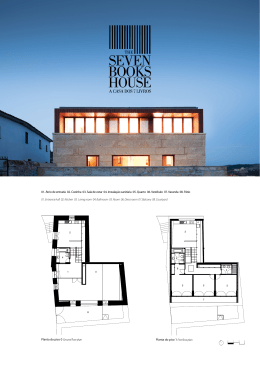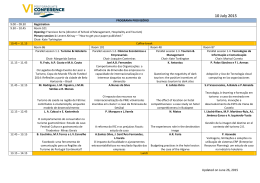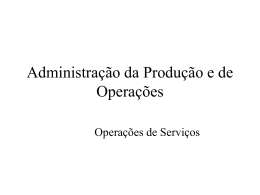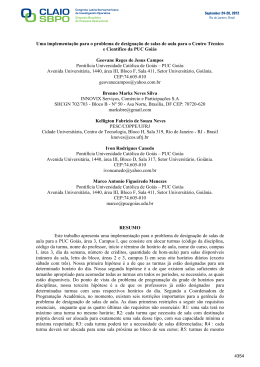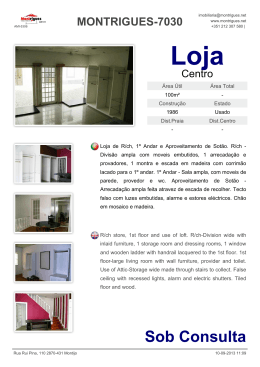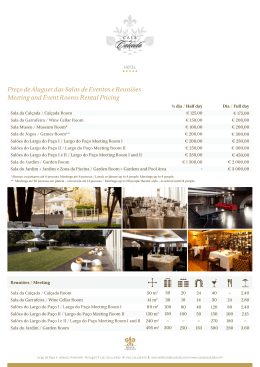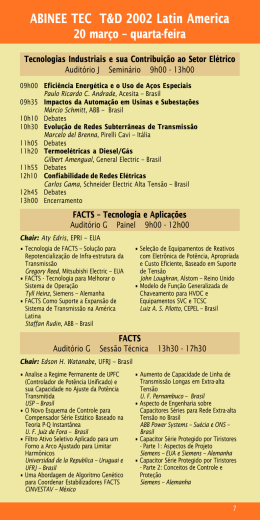Scientific Programme L Congress of the Brazilian Society of Physiology “Bridge to the Future” Sunday – August 2nd 12:00 PM – REGISTRATION OPENS 02:00 - 04:00 PM – SBFis Council Meeting (Room 8) + Multicenter Graduate Program Council Meeting (Room 9) POSTER SESSION I POSTER DISPLAY: 12:00 - 06:00 PM POSTER PRESENTATION: 03:00 - 05:00 PM 05:15 - 06:15 PM: COURSES 1-7 SAFIRA ROOM: Course 1 – Effects of physical exercise in the Central Nervous System - Chair: Pâmela Mello-Carpes (UNIPAMPA) - Aula 1: Effects of exercise on cognitive deficits associated with maternal deprivation - Fernando Benetti (UFRGS) e Pâmela Carpes (UNIPAMPA) ROOM 8: COURSE 2 – XIII Oficina de ensino de graduação - Chair: Maria Tereza Nunes (ICBUSP) - Aula 1: Uso de jogo instrucional no processo ensino-aprendizagem do sistema locomotor - Kelly Cristina Gavião (Faculdade Pitágoras – Poços de Caldas) 1 RUBI ROOM: COURSE 3 – Cardiac Electrophysiology and Basic Mechanisms of Arrhythmogenesis - Chair: José Geraldo Mill (UFES) - Aula 1: Electrophysiologic recordings: from tissue to the ionic channel - Jader S. Cruz (UFMG) ROOM 7: COURSE 4 – Fisiologia Renal para todos - Chair: Jackson de Souza Menezes (UFRJ) e Raif Musa Aziz (ICB/USP) - Aulas 1 – PARTE 1: Desmistificando a biofísica aplicada a fisiologia renal - Joaquim Procópio de Araujo Filho (ICB – USP). PARTE 2: A fácil hemodinâmica aplicada ao funcionamento dos rins Maria Oliveira de Souza (ICB – USP) ROOM 9: COURSE 5 – O Estado da Arte do óleo de peixe – Ele é tão saudável quanto se pensa? Chair: Ricardo Fernandez Perez (UFPR) - Aula 1: Ácido graxo n-3. Da bancada à Clínica - Luiz Claudio Fernandes (UFPR) ESMERALDA ROOM: COURSE 6 – Métodos e técnicas aplicadas ao estudo da função hipotalâmica - Chair: Silvia Graciela Ruginsk Leitão (UNIFAL) - Aula 1: Quantificação da expressão de RNAm no hipotálamo: PCR em Tempo Real - Silvia Graciela Ruginsk Leitão (UNIFAL) TOPAZIO ROOM: COURSE 7 – Neuroimmunoendocrinology - Chair: Maria José Alves da Rocha (FORP/USP) - Aula 1: Introduction to the Neuroimmunoendocrinology - Rafael Simone Saia (FMRP - USP) 06:30 - 07:00 PM RUBI ROOM: OPENING CEREMONY 07:00 - 08:00 PM RUBI ROOM: PLENARY LECTURE 1 Denis Noble (ENGLAND) - What is Life? The answer from the physiology of the twenty-first century Introduction: Vagner R. Antunes (ICB - USP) Monday – August 3rd 07:00 AM – REGISTRATION OPENS 2 07:30 – 08:30 AM: COURSE 8-14 SAFIRA ROOM: COURSE 8 – Da sinapse à rede: a integração da informação neural – Chair: Daniela Accorsi-Mendonça (FMRP/USP)- Aula 1: A sinapse como estrutura mínima de informação neural - Daniela Accorsi-Mendonça (FMRP- USP) RUBI ROOM: COURSE 9 – Fisiologia do exercício: o destreinamento físico como fator gênese da obesidade – Chair: Dr. Rogério Antonio Laurato Sertié (ICB/USP) - Aula 1: Fisiologia do tecido adiposo: aspectos gerais relacionados à obesidade - Prof. Dr. Fábio Bessa Lima (ICB- USP) ROOM 8: COURSE 10 – Evaluating the teaching – learning process – Chair: Fernanda Klein Marcondes (FOP/UNICAMP) - Aula 1: Informal assessment and flipping the classroom - Dee Unglaub Silverthorn ESMERALDA ROOM: COURSE 11 – Análise da Variabilidade da Frequência Cardíaca: Métodos Clássicos e Atuais – Chair: Rubens Fazan Jr. (FMRP - USP) - Aula 1: Variabilidade da frequência cardíaca e modulação autonômica cardiovascular: análise espectral da VFC - Daniel Penteado Martins Dias (FMRP – USP) ROOM 9: COURSE 12 – Morphofunctional evaluation of the enteric nervous system – Chair: Armenio Aguiar dos Santos (UFC) - Aula 1: Pathophysiology of the enteric nervous system: Toxoplasmosis-induced changes - Eduardo José de Almeida Araújo (UEL) TOPAZIO ROOM: COURSE 13 – Stress-induced cardiac, endocrine and behavioral responses – Chair: Regina Celia Spadari (UNIFESP) - Aula 1: Stress and cardiovascular risk: role of adrenergic receptors and metabolism - Regina Célia Spadari (UNIFESP) e Viviane de Menezes Carceres (UFSC) 08:40 – 09:30 AM: KEYNOTE LECTURE 1-5 RUBI ROOM: KEYNOTE LECTURE 1 Loren Eugene Wold (USA) - Environmental priming of heart disease Introduction: Angelina Zanesco (UNESP) 3 ESMERALDA ROOM: KEYNOTE LECTURE 2 William K. Milsom (CANADA) - Cardio-respiratory physiology of High-fliers Introduction: Luciane Gargaglioni (UNESP) TOPAZIO ROOM: KEYNOTE LECTURE 3 Robson dos Santos (BRAZIL) - Renin-angiotensin system: new insights from Alamandine Introduction: Maria José Campagnole-Santos (UFMG) ROOM 7: KEYNOTE LECTURE 4 Julie Chan (TAIWAN) - Mitochondrial biogenesis and bioenergetics in neural control of blood pressure Introduction: Benedito H. Machado (FMRP - USP) SAFIRA ROOM: KEYNOTE LECTURE 5 René J. Bindels (NETHERLANDS) - Step stones towards our understanding of renal calcium and magnesium handling Introduction: Jackson de Souza Menezes (UFRJ) 09:30 – 10:00 AM: BREAK 10:00 AM – 12:00 PM: SYMPOSIUM 1-7 RUBI ROOM: SYMPOSIUM 1 – Hydrogen sulfide role as a mediator in inflammatory process Chair: Terezila Machado Coimbra (FMRP/USP) - Rui Wang - Hidrogen sulfide is an endothelium-derived hyperpolarizing factor - Fernando Q. Cunha - Hydrogen sulfide as a mediator in cellular events involved in inflammatory process - Luiz Guilherme S. Branco - Hydrogen sulfide in systemic inflammation - Francescato HDC - Hydrogen sulfide in renal inflammation SAFIRA ROOM: SYMPOSIUM 2 – Integrated Teaching of Physiology - Chair: Fernanda Klein Marcondes (FOP - UNICAMP) - Peneloppe Hansen - What I wish I’d known when I started teaching physiology - Beatriz U. Ramirez - Learning Styles Preferences and Physiology teaching 4 - Fernanda Klein Marcondes - Integrated Physiology Discipline: 10 years-experience of Piracicaba Dental School, UNICAMP, Brazil ESMERALDA ROOM: SYMPOSIUM 3 – Excitation-contracting coupling in the normal and hypertrophied myocardium - Chair: José Geraldo Mill (UFES) - Alicia Mattiazzi - Role of CaMKII in regulation of calcium fluxes in the myocardium - Patrícia Brum - Exercise training and improvement of myocardial contractility - Metin Avkiran - Role of sodium on the regulation of myocardial contractility - Miguel A. Carneiro Júnior - Exercise training and Ca fluxes in isolated cardiac myocytes - Luiz Bozi - Effects dynamic exercise in the contractile function of myocytes of infarct rats TOPAZIO ROOM: SYMPOSIUM 4 – Cardiorespiratory aspects in Neural Diseases - Chairs: Andre Henrique Freiria-Oliveira (UFG) e Graziela Torres Blanch (PUC-GO) - Colin Sumners - The Protective Renin-Angiotensin System in Stroke - Norberto Garcia-Cairasco - Epilepsy and Neuropsychiatry Comorbidities as Complex Challenges to Neural and Cardio-Respiratory Systems - Ana C. Takakura - Cardiorespiratory deficits in a rat model of Parkinson’s disease Oral Communications: a) A6 noradrenergic neurons are recruited in a rat model of Parkinson’s disease. Luiz M. Oliveira, Marina Tuppy, Thiago S. Moreira and Ana C. Takakura. Dept of Pharmacology, Institute of Biomedical Science, USP. b) Ischemic stroke decreases serum activity of angiotensin converting enzyme 2 in correlation with systolic blood pressure in humans. Douglas M. Bennion, Christian Rosado, Emily A. Haltigan, Micahel F. Walters and Colin Sumners. Department of Physiology and Functional Genomics, University of Florida, USA. ROOM 7: SYMPOSIUM 5 – Temperature matters in Human and Animal Physiology - Chairs: Kenia Cardoso Bícego (FCAV/UNESP) e Maria Camila Almeida (UFABC) - Alexandre A. Steiner - Temperature matters: does hypoxia always happen in endotoxic shock? - Maria Camila Almeida - Ambient temperature affects psychological and behavioral variables- role of thermo-TRP channels - Kênia Cardoso Bícego - Thermal relation and chemical mediators in early life in chicks 5 - Carolina S. Scarpellini - Interaction between osmoregulation and thermoregulation in response to heat in lizards - Guilherme Gomes - Thermoregulatory and neurophysiological responses in insects ROOM 8: SYMPOSIUM 6 – Calcium signaling: molecular mechanisms involved at different physiological processes - Chair: Lusiane Bendhack (FCFRP-USP) - Cecilia Hidalgo (CHILE) - Crosstalk between ROS and Calcium Signalling in Synaptic Plasticity - Jens Rettig (GERMANY) - The other synapse: Calcium-dependent exocytosis in the immune system Oral communications: a) Effects of a Green Tea on Memory and Oxidative Balance after Different Stroke Models in Rats. Caroline Dalla Colletta Altermann, Alexandre G. dos Santos, Alexandre S. Martins, Helen L. Schimidt, Mauren A. de Souza and Pamela B. Mello Carpes . Federal University of Pampa, RS, Brazil b) Alamandine signaling in cardiomyocytes in healthy and disease. Itamar C.G. de Jesus, Sérgio R.A. Scalzo Jr, Cibele R. Resende, Thais C. Alcântara, Robson A. dos Santos and Silvia C. Guatimosim. Dept of Physiology and Biophysics, Federal University of Minas Gerais. ROOM 9: SYMPOSIUM 7 – Pós-graduação em Fisiologia: controvérsias e perspectivas futuras Chairs: Adalberto R Vieyra (Coordenador do CB-II-CAPES) & Patrícia Rocco (Comissão da PG da SBFis) - José Antunes Rodrigues (FMRP-USP): Como estimular a fisiologia no Brasil. - Aldo Lucion (UFRGS): Pós graduação Multicêntrica em Fisiologia: Prós e contras - Adelina M Reis (UFMG)Perfil de excelência de programas na área de fisiologia” - Carmen Cabanela Pazos de Moura (UFRJ): Como manter uma pós graduação nível 7 em fisiologia: desafios e metas. - Lívio Amaral (CAPES): Plataforma sucupira para fisiologia: one fits all 12:00 – 01:30 PM: LUNCH BREAK POSTER SESSION II POSTER DISPLAY: 08:30 - 06:00 PM 6 POSTER PRESENTATION: 01:30 - 03:30 PM 03:45 – 05:45 PM: SYMPOSIUM 8-13 SAFIRA ROOM: SYMPOSIUM 8 – Development of animal models of cardiorespiratory diseases - Chair: P Patricia R. M. Rocco (UFRJ) - Bela Suki - How to develop an animal model of emphysema? Pros and Cons - Patricia R. M. Rocco - Acute respiratory distress syndrome: how to develop a perfect model? - José Geraldo Mill - Acute and chronic myocardial infarction - Soraia Abreu - Reproducible model of allergic asthma - Frances Moody-Corbett - The role of Animal Models in Understanding Chronic Disease TOPAZIO ROOM: SYMPOSIUM 9 – Salt and Hypertension: What does the CNS knows about? Chair: Eduardo Colombari (FOAr/UNESP) & Gustavo R. Pedrino (UFG) - Glenn M. Toney - How the Forebrain-Hypothalamic Sympathoexcitatory Network Interfaces with the Brainstem Sympathetic Rhythm Generating Network - Eduardo Colombari - Sympathetic and respiratory activities during increases in osmolarity in an in situ rat preparation Oral communications: a) Role of carotid body and forebrain in the sympathetic and respiratory responses induced by hyperosmolality. Elaine F. da Silva, Mirian Bassi, José V. Menani, Daniel B. Zoccal, Gustavo R. Pedrino, Debora S.A. Colombari and Eduardo Colombari. Dept of Physiology and Pathology, School of Dentistry, UNESP. b) Involvement of the median preoptic nucleus in tonic control of the renovascular hypertension. Aline A Mourão, Marina C. S. Moreira, Aryanne B.S. de Melo, Graziela T. Blanch, Andre H Freiria-Oliveira and Gustavo R. Pedrino. Dept of Physiology and Biophysics, Federal University of Goias. c) Effects of high salt diet during the postnatal period on water and sodium intake induced cellular and extracellular dehydration in the adult phase. Aryanne B.S. de Melo, Thais M. Mercês, Graziela T. Blanch, Gustavo R. Pedrino and Andre H Freiria-Oliveira. Dept of Physiology and Biophysics, Federal University of Goias. 7 ROOM 7: SYMPOSIUM 10 – Nonreproductive effects of estradiol - Chair: Andre de Souza Mecawi (UFRRJ) - Maria Julia Cambiasso - Estradiol compensates sex chromosome induced sexual dimorphism in the embryonic brain - Paula Beatriz Marangon - Estradiol controlling thirst and sodium appetite - Emerson Lopes Olivares - Estradiol effects on heart dysfunction models - Gislaine de Almeida Pereira - Estradiol modulates neuroendocrine responses to central angiotensin II - Tatiane Vilhena Franco - Estradiol modulates neurohypophyseal activation induced by osmolality and volume challenges ROOM 8: SYMPOSIUM 11 – Molecular regulation of energy homeostasis, metabolism, inflammation and aging - Chair: William L. Festuccia (ICB/USP) - Felipe Valença Pereira - Metabolism, microbiota and immune system: a network for tissue homeostasis - Marcelo Mori - Dicing a Way through Life: Dietary Restriction Requires Dicer Function in Adipose Tissue to Promote its Beneficial Effects - William Festuccia - Nutrient sensors as regulators of metabolism and inflammation RUBI ROOM: SYMPOSIUM 12 – Counterpoint between physical inactivity and exercise to identify the mechanisms and to manage cardiovascular diseases: translational aspects Chair: Antonio Claudio Lucas da Nobrega (UFF) - Lisete Michelini - Inactivity augments, but exercise training corrects autonomic dysfunction in hypertension: mechanisms involved - Lauro Vianna - Intrathecal fentanyl abolishes the exaggerated pressor response to exercise in human hypertension - Antonio Nobrega - Aerobic training, vascular reactivity, and nitric oxide synthase in experimental model of early metabolic syndrome - Bruno Silva - Aerobic exercise acutely prevents the endothelial dysfunction induced by mental stress among subjects with metabolic syndrome: the role of shear rate - Igor Alexandre Fernandes - Cerebrovascular Reactivity to Conditions of Sympathoexcitation: The Impact of Hypertension ESMERALDA ROOM: SYMPOSIUM 13 – Desafios futuros das Ciências Fisiológicas no Brasil Chair: Maria José Campagnole-Santos (UFMG) 8 - Eduardo M. Krieger - Novos desafios e perspectivas da Fisiologia no Brasil - Robson A.S. Santos - Da idéia ao produto - experiências de um fisiologista - Ruben Sinisterra - Como construir a ponte para acelerar a inovação no Brasil a partir do conhecimento científico ROOM 9: LEICA MICROSYSTEMS SYMPOSIUM - Chair: Brazilian Society of Physiology (SBFis) 06:00 – 07:00 PM: COURSE 1-7 SAFIRA ROOM: COURSE 1 – Effects of physical exercise in the Central Nervous System – Chair: Pâmela Mello-Carpes (UNIPAMPA) - Aula 2: Respiratory muscle training and neurodegenerative diseases - Gustavo Dias Ferreira ROOM 8: COURSE 2 – XIII Oficina de ensino de graduação – Chair: Maria Tereza Nunes (ICBUSP) - Aula 2: Modelos analógicos no ensino de Fisiologia - Paulo Fernando Guedes Pereira Montenegro RUBI ROOM: COURSE 3 – Cardiac Electrophysiology and Basic Mechanisms of Arrhythmogenesis - Chair: José Geraldo Mill (UFES) - Aula 2: Potassium channels and cardiac repolarization process - Emiliano Medei ROOM 7: COURSE 4 – Fisiologia Renal para todos - Chair: Jackson de Souza Menezes (UFRJ) e Raif Musa Aziz (ICB/USP) - Aula 2: PARTE 1: Porque os sistemas de secreção e reabsorção dependem de gradiente eletroquímico? - Jackson de Souza Menezes. PARTE 2: Regulação do volume? Regulação da tonicidade? Isso é difícil? Não é - Jackson de Souza Menezes ROOM 9: COURSE 5 – O Estado da Arte do óleo de peixe – Ele é tão saudável quanto se pensa? - Chair: Ricardo Fernandez Perez (UFPR) - Aula 2: Efeito da suplementação com óleo de peixe na função renal em modelos animais de caquexia e obesidade - Isabela Coelho de Castro e Ricardo Fernandez ESMERALDA ROOM: COURSE 6 – Métodos e técnicas aplicadas ao estudo da função hipotalâmica – Chair: Silvia Graciela Ruginsk Leitão (UNIFAL) - Aula 2: Imunodetecção de proteínas no Hipotálamo - André de Souza Mecawi 9 TOPAZIO ROOM: COURSE 7 – Neuroimmunoendocrinology – Chair: Maria José Alves da Rocha (FORP/USP) - Aula 2: Effect of the stress on the immune system - Cristina Ribeiro de Barros Cardoso RUBI ROOM: 07:00 – 08:00 PM – SBFis General Assembly Tuesday – August 4th 07:00 – 08:30 AM: COURSE 8-14 SAFIRA ROOM: COURSE 8 – Da sinapse à rede: a integração da informação neural - Chair: Daniela Accorsi-Mendonça (FMRP/USP) - Aula 2: Propriedades intrínsecas da membrana neuronal e a integração da informação sináptica Ricardo M. Leão RUBI ROOM: COURSE 9 – Fisiologia do exercício: o destreinamento físico como fator gênese da obesidade – Chair: Rogério Antonio Laurato Sertié (ICB/USP) - Aula 2: As repercussões do destreinamento físico sobre o metabolismo do tecido adiposo branco: análise sítio específica - Rogério Antonio Laurato Sertié ROOM 8: COURSE 10 – Evaluating the teaching – learning process – Chair: Fernanda Klein Marcondes (FOP/UNICAMP) - Aula 2: The Design and Evaluation of Multiple Choice Questions - Robert Carroll ESMERALDA ROOM: COURSE 11 – Análise da Variabilidade da Frequência Cardíaca: Métodos Clássicos e Atuais – Chair: Rubens Fazan Jr. (FMRP - USP) - Aula 2: Principais métodos para estudo das dinâmicas não lineares da VFC – Luiz Eduardo Virgílio da Silva ROOM 9: COURSE 12 – Morphofunctional evaluation of the enteric nervous system – Chair: Armenio Aguiar dos Santos (UFC) - Aula 2: Morphofunctional and molecular aspects of the enteric neurons in the gastrintestinal tract submitted to ischemia/reperfusion process - Patricia Castelucci 10 TOPAZIO ROOM: COURSE 13 – Stress-induced cardiac, endocrine and behavioral responses – Chair: Regina Celia Spadari (UNIFESP) - Aula 2: Stress and β-adrenergic signaling in cardiac remodeling - André Luiz de Moura e Ricardo de Moura Conrado 08:40 – 09:30 AM: KEYNOTE LECTURE 6-10 RUBI ROOM: KEYNOTE LECTURE 6 Michael Hoppa (USA) - Control and plasticity of the presynaptic action potential waveform at small central nervous system nerve terminals Introduction: Fernando Rodrigues de Moraes Abdulkader (ICB/USP) ESMERALDA ROOM: KEYNOTE LECTURE 7 Martin Young (USA) - Just like Clockwork – Circadian Control of Cardiac Function and Dysfunction Introduction: Maria Tereza Nunes (ICB/USP) TOPAZIO ROOM: KEYNOTE LECTURE 8 Bela Suki (USA) - Mechanical stress-induced lung remodeling in emphysema Introduction: Patricia R. M. Rocco (UFRJ) SAFIRA ROOM: KEYNOTE LECTURE 9 Tobias Wang (DENMARK) - The cardiovascular physiology of giraffes: the tallest animal on earth Introduction: Luciane H. Gargaglioni (FCAV-UNESP) ROOM 7: KEYNOTE LECTURE 10 Yang-Sook Chun (SOUTH COREA) - Epigenetic regulation of stem cell differentiation via histone dynamics Introduction: Thiago S. Moreira (ICB-USP) 09:30 – 10:00 AM: BREAK 10:00 AM – 12:00 PM: SYMPOSIUM 14-19 ESMERALDA ROOM: SYMPOSIUM 14: Hindbrain control of sodium appetite - Chairs: Laurival A. De Luca Jr (FOAr/UNESP) & Carina Ap. Fabrício de Andrade (FOAr/UNESP) 11 - Jose Vanderlei Menani: Role of parabrachial nucleus on sodium and water intake behaviour - Luís Carlos Reis: Role of dorsal raphe nucleus in control of sodium appetite. Oral communications: a) Mineral preference in rats treated with injections of muscimol into the lateral parabrachial nucleus. João C. Callera, Laurival A. De Luca Jr. and José V. Menani. Dept of Basic Science, School of Dentistry, UNESP. b) Possible involvement of the inhibitory mechanisms of the lateral parabrachial nucleus in the control of sodium intake in renovascular hypertensive rats. Richard B. David, Camila F. Roncari, Mariana R. Lauar, Regina C. Vendramini, Debora S.A. Colombari, Carina A.F. Andrade, José V. Menani and Laurival A. De Luca Jr. Dept of Physiology and Pathology, School of Dentistry, UNESP. c) Serotonergic activation in the NTS inhibits water intake induced by central angiotensin II. Rodrigo A. Tomeo, Jose V. Menani and Patrícia M. de Paula. Dept of Physiology and Pathology, School of Dentistry, UNESP. d) Dieta hipossódica por quatro dias leva a respostas ansiolíticas no modelo labirinto em cruz elevado. Evandro V. de Lima, Tatiane V. Franco, Quézia S.R. Carbalan, Iracema G. de Araujo, Luis C Reis, Lucila L. Elias, Jose Antunes-Rodrigues and André S. Mecawi. Dept of Physiological Science, UFRRJ. ROOM 8: SYMPOSIUM 15 – Advances on the pathophysiology of the gastrointestinal motility Chair: Armenio Aguiar dos Santos (UFC) - Daniel Sifrim - Role of esophageal permeability to the gastroesophageal reflux disease - Ricardo Brandt de Oliveira - Posture-induced changes on the function of the lower esophageal sphincter in humans - Miguel Ângelo Nobre e Souza - Inspiratory muscle training improves antireflux barrier in subjects with gastroesophageal reflux disease - Raimundo C. Palheta Jr. - Posture-induced changes (tilt test) in the gastric emptying of liquid in awake rats - José Ricardo de Arruda Miranda - The assessment of gastrointestinal motility of rats by magnetic nanoparticles 12 RUBI ROOM: SYMPOSIUM 16 – New advances of the old and new components of the reninangiotensin system - Chair: Maria Jose Campagnole-Santos (UFMG) and Maria Cláudia Irigoyen - Maria Jose Campagnole-Santos - Cardiometabolic actions of angiotensin-(1-7) through the central nervous system - Maria Cláudia Irigoyen - Renin-angiotensin system modulation of the autonomic control - Edilamar M Oliveira - Molecular adaptations of the cardiac renin-angiotensin system in exercise training - Rafaela Fernandes da Silva - Role of angiotensin-(1-7) in atherosclerotic plaque progression and stabilization SAFIR ROOM: SYMPOSIUM 17 – Influence of environmental factors and hormones on tissue metabolism - Chair: Maria Tereza Nunes (ICB/USP) - Martin Young - Circadian regulation of metabolism - José Cipolla Neto - Melatonin and the regulation of energy metabolism - Rodrigo Antonio Peliciari-Garcia - Thyroid hormones and the circadian clock in the heart - Ana Carolina Panveloski-Costa - Effect of thyroid hormone on insulin sensitivity and heart of type 1 diabetic rats TOPAZIO ROOM: SYMPOSIUM 18: Synaptic transmission in NTS and autonomic responses Chair: Daniela Accorsi-Mendonça (FMRP/USP) - Daniela Accorsi-Mendonça - Hypoxia and synaptic transmisison at the NTS - Lisete Compagno Michelini - NTS mechanisms underlying baroreceptor resetting during exercise - Débora de Almeida Colombari - Mecanismos colinérgicos do NTS envolvidos com a regulação cardio-respiratória. Oral communications: a) Selective denervation of the aortic and carotid baroreceptors. Jaci A. Castania, Pedro L. Katayama, Fernanda Brognara, João Paulo J. Sabino, Rubens Fazan and Helio C. Salgado. Dept of Physiology, School of Medicine of Riberião Preto, USP. b) Baroreflex activation in conscious rats modulates the joint inflammatory response via sympathetic function. Fernanda Brognara, Gabriel S. Bassi, Jaci A. Castania, Jhimmy Talbot, Thiago M. Cunha, Fernando Q. Cunha, Luis Ulloa, Alezandre Kanashiro, Daniel P.M. Dias, Helio C. Salgado. Dept of Physiology, School of Medicine of Riberião Preto, USP. 13 c) Increase in parasympathetic function by acetylcholinesterase inhibition prevents sympathoexcitation and baroreflex dysfunction in heart failure rats. Renata, M. Lataro, Carlos A. A. Silva, Daniel P.M. Dias, Fernanda, M. Santos-Almeida, Rubens Fazan, Helio C. Salgado. Dept of Physiology, School of Medicine of Riberião Preto, USP. ROOM 7: SYMPOSIUM 19: Physiological Interaction of the Respiratory System - Chair: Pedro Leme Silva (UFRJ) - Carla Prado - Lung and Redox Status: Therapeutic Proposals - Felipe Dal Pizzol - Inflammation and Neurodegeneration - Jackson Menezes - Lung-Kidney Interaction: Healthy and Pathologic States - Pedro Leme Silva - Cardiopulmonary Interaction: Global Hemodynamic Toward Microvascular Environment - Priscilla Olsen - Immune System and Lung 12:00 – 01:30 PM: LUNCH BREAK POSTER SESSION III POSTER DISPLAY: 08:30 - 06:00 PM POSTER PRESENTATION: 01:30 - 03:30 PM 03:45 – 05:45 PM: SYMPOSIUM 20-25 ESMERALDA ROOM: SYMPOSIUM 20: Aerobic training as a therapeutic tool in Heart Failure: a translational approach - Chair: Lisete Compagno Michelini (ICB/USP) - Carlos Eduardo Negrão: Physiopatology of the Heart Failure: autonomic and neurovascular mechanisms. - Marcelo H. A. Ichige: Aerobic training affects sympatho-vagal balance to the heart in infarcted rats - Patrícia C. Brum: Effects of continuous and high-intensity intervaleted aerobic training on the skeletal muscle in infarcted rats. - Lígia M. Antunes-Correa: Effects of aerobic training on autonomic control in heart failure patients. - Igor Lucas Gomes-Santos: Effects of aerobic training on the renin-angiotensin system in heart failure. ROOM 9: SYMPOSIUM 21 – Research and Publication in Physiology Teaching - Chair: Fernanda Klein Marcondes (UNICAMP) 14 - Pâmela Billig Mello-Carpes - Learning and Memory: from basic research to research applied to classroom - Maria Tereza Nunes - Working models of active learning in classrooms with many students and a single teacher - Robert Caroll - First Steps – Submitting educational materials to the “Life Science Teaching Resource Community” - Peter Wagner - Educational articles in research journals: A journal editor's perspective TOPAZIO ROOM: SYMPOSIUM 22: Cardiorespiratory function in vertebrates - Chair: Luciane H. Gargaglioni (FCAV/UNESP) - Glauber S.F. da Silva - Respiratory function in lungfish. - Luciane H. Gargaglioni - Orexinergic neurotransmission and respiratory control in mammals and amphibians. - Wilfried Klein - The chelonian respiratory system: recent insights regarding its form and function. - Lucas Zena - Cardiorespiratory interaction in amphibians. - Marina Sartori Controle - Autonomic control of the heart in reptilian embryos. SAFIRA ROOM: SYMPOSIUM 23: The role of fetal programming in the development of cardiovascular, renal and metabolic diseases: clinical and experimental aspects - Chair: Guiomar Nascimento Gomes (UNIFESP) - Maria do Carmo Pinho Franco: Low birth weight is an additional risk factor? Characterization of the Inter- relationship between the Risk Factors of CardioMetabolic and Genetic /Epigenetic Patterns. - Guiomar Nascimento Gomes: Sleep restriction as an inductive factor of fetal programming. - Aparecida Emiko Hirata: The effect of gestational diabetes in the development of insulin resistance in adult offspring: The Role of Oxidative Stress. - Diego Soares Carvalho: Effects of gestational diabetes on pancreatic functionality of the offspring. - Vanessa Oliveira: Aerobic training normalizes the mitochondrial DNA content and the expression of the receptor type TOLL 9 in the offspring submitted to intra- uterine nutrient restriction. ROOM 7: SYMPOSIUM 24: Redox signaling in cardiac diseases - Chair: Adriane Belló-Klein (UFRGS) - Martin Vila-Petroff CaMKII and ROS signaling in cardiac myocyte apoptosis - Daniele Mancardi: Hydrogen sulfide in the hypoxia/reoxygenation scenario. - Kátia de Angelis: Autonomic dysfunction and oxidative stress in myocardial infarction. 15 - Alex Sander Araújo: Thyroid hormones effect on redox state and cardiac remodeling after myocardial infarction. - Rafael Colombo: Redox signaling in right ventricular failure. RUBI ROOM: SYMPOSIUM 25 – SBFis: ÁLVARO OZÓRIO DE ALMEIDA AWARD The 5 contestants finalists will be selected from all abstracts to be submitted to the Congress 06:00 – 07:00 PM: COURSES 1-7 SAFIRA ROOM: Course 1 – Effects of physical exercise in the Central Nervous System - Chair: Pâmela Mello-Carpes (UNIPAMPA) - Aula 3: Exercício físico no envelhecimento: Efeitos na memória de longa duração. Felipe P Carpes (UNIPAMPA) e Pâmela Mello-Carpes (UNIPAMPA) ROOM 8: COURSE 2 – XIII Oficina de ensino de graduação - Chair: Maria Tereza Nunes (ICBUSP) - Aula 3: Desafiando a curva glicêmica de indivíduos saudáveis. Marcia Carvalho Garcia (Faculdade de Medicina de Jundiaí) RUBI ROOM: COURSE 3 – Cardiac Electrophysiology and Basic Mechanisms of Arrhythmogenesis - Chair: José Geraldo Mill (UFES) - Aula 3: Cardiac arrhythmias: mechanisms and control. José Geraldo Mill (UFES) ROOM 7: COURSE 4 – Fisiologia Renal para todos - Chair: Jackson de Souza Menezes (UFRJ) e Raif Musa Aziz (ICB/USP) - Aula 3: - PARTE 1: Elimina ácido ou base? Quem decide é o rim. Raif Musa Aziz (ICB – USP)PARTE 2: Mesa redonda: Por que estudar a fisiologia renal? A visão de diferentes gerações. Gerhard Malnic (ICB – USP), Jackson de Souza Menezes, Carolina Monteiro de Lemos Barbosa e Jessica Kabutamori Rosa ROOM 9: COURSE 5 – O Estado da Arte do óleo de peixe – Ele é tão saudável quanto se pensa? Chair: Ricardo Fernandez Perez (UFPR) - Aula 3: "Óleo de fígado de tubarão e seus efeitos sobre crescimento tumoral, caquexia e sistema imunitário". Fabíola Iagher (UFPR) 16 ESMERALDA ROM: COURSE 6 – Métodos e técnicas aplicadas ao estudo da função hipotalâmica - Chair: Silvia Graciela Ruginsk Leitão (UNIFAL) - Aula 3: Eletrofisiologia de Células Hipotalâmicas. Melina Pires da Silva (FMRP - USP) TOPAZIO ROOM: COURSE 7 – Neuroimmunoendocrinology - Chair: Maria José Alves da Rocha (FORP/USP) - Aula 3: Neuroimmunoendocrino alterations during sepsis. Maria José Alves da Rocha (FORP – USP) Wednesday – August 5th 07:30 – 08:30 AM: COURSES 8-14 SAFIRA ROOM: COURSE 8 – Da sinapse à rede: a integração da informação neural - Chair: Daniela Accorsi-Mendonça (FMRP/USP) - Aula 3: Redes Neuronais - Davi José de Almeida Moraes RUBI ROOM: COURSE 9 – Fisiologia do exercício: o destreinamento físico como fator gênese da obesidade – Chair: Proponente: Rogério Antonio Laurato Sertié (ICB/USP) - Aula 3: O turnover celular do tecido adiposo: a influência da interrupção do exercício físico sobre os fenômenos de apoptose e adipogênese - Rogério Antonio Laurato Sertié ROOM 8: COURSE 10 – Evaluating the teaching – learning process – Chair: Fernanda Klein Marcondes (FOP/UNICAMP) - Aula 3: Formal assessment - Luis Henrique Montrezor ESMERALDA ROOM: COURSE 11 – Análise da Variabilidade da Frequência Cardíaca: Métodos Clássicos e Atuais – Chair: Rubens Fazan Jr. (FMRP - USP) - Aula 3: Utilização dos programas computacionais CardioSeries e JBioS para análise da variabilidade cardiocirculatória - Rubens Fazan Jr ROOM 9: COURSE 12 – Morphofunctional evaluation of the enteric nervous system – Chair: Armenio Aguiar dos Santos (UFC) - Aula 3: Role of the enteric glial cells in the gut inflammatory pathologies- Gerly Anne de Castro Brito e Profa. Dra. Antoniella Souza Gomes Duarte 17 TOPAZIO ROOM: COURSE 13 – Stress-induced cardiac, endocrine and behavioral responses – Chair: Regina Celia Spadari (UNIFESP) - Aula 3: Stress-induced behavioral and endocrine responses: effects of comfort food - Daniela Ortolani e Marcia Carvalho Garcia 08:30 – 09:20 AM: KEYNOTE LECTURE 11-15 ROOM 7: KEYNOTE LECTURE 11 Ryuji Inoue (JAPAN) - Dynamic regulation of TRPC and TRPM4 channels by endogenous PIP2 level investigated by voltage-sensing phosphatase and FRET Introduction: Maria J. Campagnole-Santos (UFMG) ESMERALDA ROOM: KEYNOTE LECTURE 12 Ludmila Filaretova (RUSSIA) - Activation of the HPA axis as gastroprotective component of stress response Introduction: Armenio Aguiar dos Santos (UFC) TOPAZIO ROOM: KEYNOTE LECTURE 13 Peter Wagner (USA) - Fundamental systems physiology in high altitude Tibetans Introduction: Benedito H. Machado (FMRP-USP) SAFIRA ROOM: KEYNOTE LECTURE 14 Metin Avkiran (ENGLAND) - Cardiac plasticity: mechanisms of physiological and pathological hypertrophy Introduction: José Geraldo Mill (UFES) RUBI ROOM: KEYNOTE LECTURE 15 Janet Taylor (AUSTRALIA) - The Role of the Nervous System in Muscle Fatigue Introduction: Andre H. Freiria de Oliveira (UFG) 09:20 – 09:40 AM: BREAK 09:40 – 11:40 AM: SYMPOSIUM 26-31 18 ROOM 7: SYMPOSIUM 26 – Cardiovascular physiology assisted by scientific computing Chair: Luciano Gonçalves Fernandes (UFRRJ) - Luciano Gonçalves Fernandes - Afferent baroreceptor mechanisms: a computational model - Lucas Omar Müller - Cerebral venous system modelling: application to the study of Chronic Cerebro-Spinal Venous Insufficiency - Mário Sansuke Maranhão Watanabe - Anatomical and Physiologycal Aspects on the Computational Modeling of the Human Arterial Network - Rafael Alves Bonfim de Queiroz - Trends in computational modeling of circulatory trees - Paulo Roberto Trenhago - Coupled cardiovascular-respiratory model RUBI ROOM: SYMPOSIUM 27 – What is new about the Hypothalamic-Neurohypophyseal System - Chairs: José Antunes Rodrigues (FMRP/USP) e André de Souza Mecawi (UFRRJ) - Olivera Sarenac - Modulation of salt appetite by central kappa opioid system - Laura Vivas - Hydroelectrolytic homeostatic responses: maternal/perinatal influences on vasopressin system - André de Souza Mecawi - Molecular, cellular and physiological changes in the neurohypophyseal system induced by low sodium diet - Melina Pires da Silva - Differentiation between oxytocin- and vasopressin magnocellular neurons requires more than one experimental criterion - Wagner Luis Reis - Carbon Monoxide and Nitric Oxide interactions in Magnocellular Neurosecretory Neurones ESMERALDA ROOM: SYMPOSIUM 28 – Unexpected role for old signaling molecules in the cardiovascular system - Chair: Silvia Guatimosim (UFMG) - Maria de Fátima Leite: Succinate as a modulator of cardiomyocyte hypertrophy. - Lúcia Rossetti Lopes: A novel role for protein disulfide isomerase in redox signaling and cardiovascular disease. - Silvia Guatimosim: Ventricular myocytes as a source of acetylcholine in the heart? Oral communications: a) Efeito da inibição do microrna-34c* na hipertrofia de cardiomiócito em cultura celular. Clara Nóbrega, Edilamar M. Oliveira. EEFE - USP. b) NADPH oxidase regulation by polycystin-1 in cardiomyocytes. Adriana Córdova-Casanova, Ivonne Olmedo, Gina Sanches, Paulina Donoso, Zully Pedrozo. University of Chile. 19 TOPAZIO ROOM: SYMPOSIUM 29 – Neurotransmitters and Neuromodulators: role in physiological and pathophysiological processes - Chair: Maria Jose Campagnole-Santos (UFMG) - Michael Bader - Serotonin is not only a neurotransmitter: Novel functions of peripheral serotonin - Natalia Alenina - Animals lacking central serotonin reveal multiple functions of the neurotransmitter - Andre Massenssini - Angiotensin-(1-7) and AMPA glutamate receptors: the beauty and the beast in cerebral ischemia - Marco Antonio P. Fontes - Angiotensin peptides, anxiety and emotional stress SAFIRA ROOM: SYMPOSIUM 30 – Light perception for visual and non‐visual functions Chairs: Maristela de Oliveira Poletini (UFMG) e Ana Maria de Lauro Castrucci (IB/USP) - Maria Ana Contin: Retinal degeneration by low light excess: study of photoreceptor cells rods, cones and ipRGCs in rats - Ana Maria de Lauro Castrucci – Melanopsin: the circadian photopigment in non‐mammal vertebrate cells - Christina Joselevitch - Visual perception of light - Theo Mota - Segregation and integration of light processing in honeybee central neural circuits - Fernanda Amaral - Light at night: chronodisruption and health implications ROOM 8: SYMPOSIUM 31 - Permeating the gut: from biophysical principles to clinical studies - Chairs: Armenio Aguiar dos Santos (UFC) - Ricardo de Freitas Lima - Biophysical methods for evaluation of intestinal permeability - Moisés Tolentino Bento da Silva - Gastrointestinal tract in physical exercise: motility and permeability adjustments - Aldo Ângelo Moreira Lima - Gut permeability and health: biomarkers of enteropathy and field validation Oral communications: a) Nitric oxide participates in the Gastric Emptying Decrease Induced Acute Physical Exercise in Rats. Ana Karolina M. Cavalcante, Rommulo C. L. Siqueira, Lorena B. Martins, Armenio A. dos Santos, Moises T. Bento-Silva. Dept of Physical Education, Federal University of Piaui. B) Light-emitting diodes ameliorates intestinal transit in a mouse model of ulcerative colitis. Monica O. Belem, Thalita M. Carlos, Giovana M.M. de Andrade, Carla F.S. Guazelli, Victro Fattori, Dari O. 20 Toguinho Filho, Ivan F. L. Dias, Waldiceu A. Verri, Eduardo José A. Araújo. Dept of Histology, Londrina State University. 11:45 AM – 12:45 PM: RUBI ROOM: PLENARY LECTURE 2 Walter Boron (USA) - Gas Channels and physiological implications Introduction: Vagner R. Antunes (ICB-USP) 12:45 – 01:00 PM RUBI ROOM: CLOSING CEREMONY 21
Download
